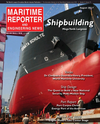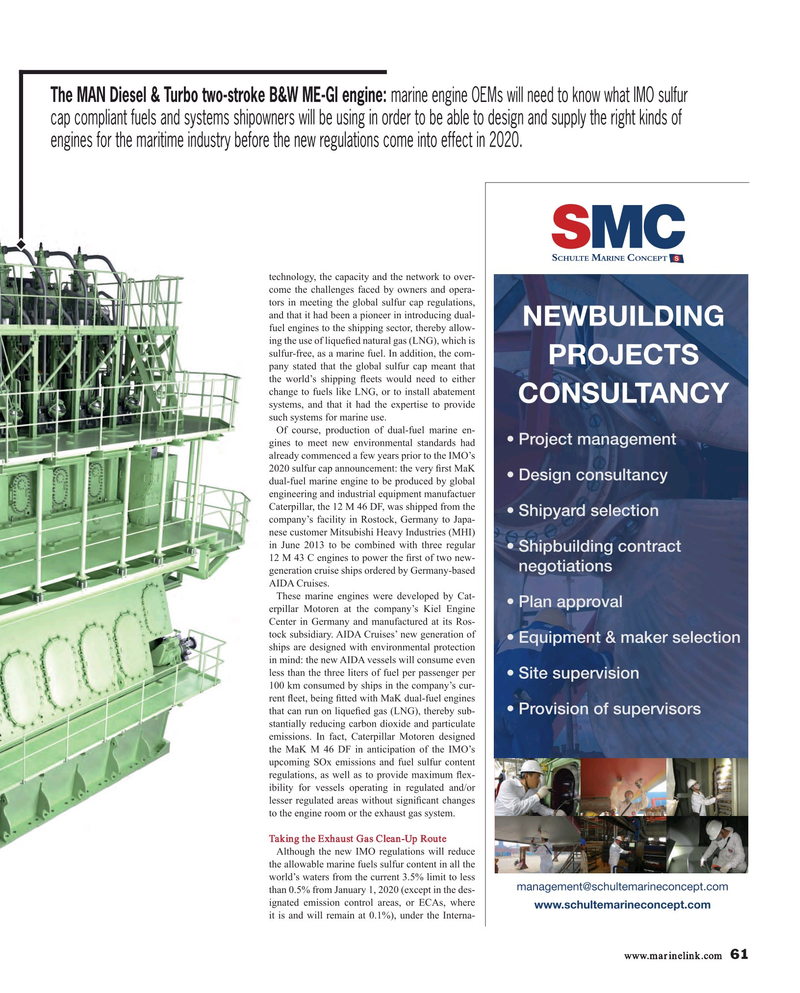
Page 61: of Maritime Reporter Magazine (August 2017)
The Shipyard Edition
Read this page in Pdf, Flash or Html5 edition of August 2017 Maritime Reporter Magazine
The MAN Diesel & Turbo two-stroke B&W ME-GI engine: marine engine OEMs will need to know what IMO sulfur cap compliant fuels and systems shipowners will be using in order to be able to design and supply the right kinds of engines for the maritime industry before the new regulations come into effect in 2020.
technology, the capacity and the network to over- come the challenges faced by owners and opera- tors in meeting the global sulfur cap regulations, and that it had been a pioneer in introducing dual-
NEWBUILDING fuel engines to the shipping sector, thereby allow- ing the use of lique? ed natural gas (LNG), which is sulfur-free, as a marine fuel. In addition, the com-
PROJECTS pany stated that the global sulfur cap meant that the world’s shipping ? eets would need to either change to fuels like LNG, or to install abatement
CONSULTANCY systems, and that it had the expertise to provide such systems for marine use.
Of course, production of dual-fuel marine en- • Project management gines to meet new environmental standards had already commenced a few years prior to the IMO’s 2020 sulfur cap announcement: the very ? rst MaK • Design consultancy dual-fuel marine engine to be produced by global engineering and industrial equipment manufactuer
Caterpillar, the 12 M 46 DF, was shipped from the • Shipyard selection company’s facility in Rostock, Germany to Japa- nese customer Mitsubishi Heavy Industries (MHI) in June 2013 to be combined with three regular • Shipbuilding contract 12 M 43 C engines to power the ? rst of two new- negotiations generation cruise ships ordered by Germany-based
AIDA Cruises.
These marine engines were developed by Cat- • Plan approval erpillar Motoren at the company’s Kiel Engine
Center in Germany and manufactured at its Ros- tock subsidiary. AIDA Cruises’ new generation of • Equipment & maker selection ships are designed with environmental protection in mind: the new AIDA vessels will consume even less than the three liters of fuel per passenger per • Site supervision 100 km consumed by ships in the company’s cur- rent ? eet, being ? tted with MaK dual-fuel engines that can run on lique? ed gas (LNG), thereby sub- • Provision of supervisors stantially reducing carbon dioxide and particulate emissions. In fact, Caterpillar Motoren designed the MaK M 46 DF in anticipation of the IMO’s upcoming SOx emissions and fuel sulfur content regulations, as well as to provide maximum ? ex- ibility for vessels operating in regulated and/or lesser regulated areas without signi? cant changes to the engine room or the exhaust gas system.
Taking the Exhaust Gas Clean-Up Route
Although the new IMO regulations will reduce the allowable marine fuels sulfur content in all the world’s waters from the current 3.5% limit to less [email protected] than 0.5% from January 1, 2020 (except in the des- ignated emission control areas, or ECAs, where www.schultemarineconcept.com it is and will remain at 0.1%), under the Interna- www.marinelink.com 61
MR #8 (58-65).indd 61 MR #8 (58-65).indd 61 8/7/2017 2:35:23 PM8/7/2017 2:35:23 PM

 60
60

 62
62
